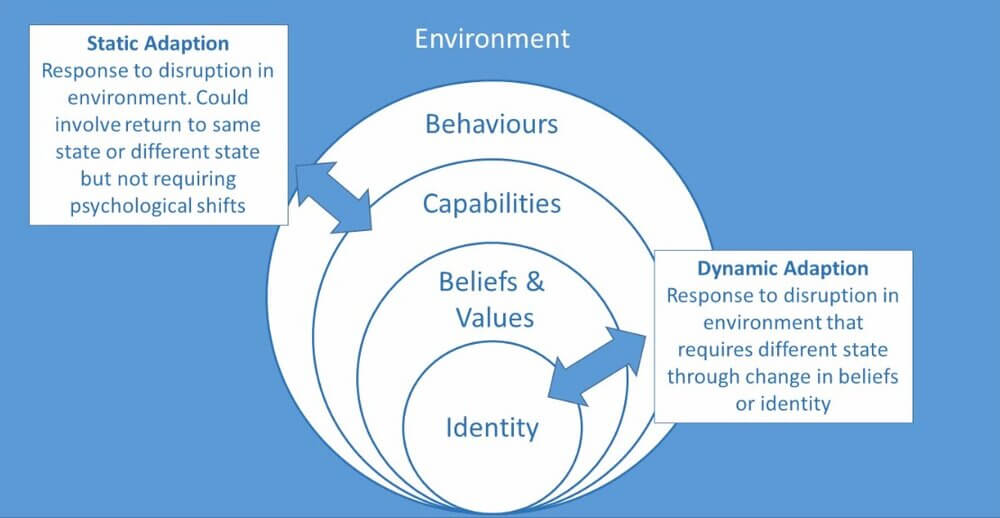Where does the need for resilience end and the need to adapt begin?

As I write this article, the agenda and possibly many of our heads are consumed by COVID-19. Whether we are concerned about the disease itself or the implications of its sweep across the globe, the disruption to our daily lives, thoughts and energy levels is significant.
Of the many definitions of resilience and flexibility, all refer to responding to something and returning to the same state. Our hopes may be that the disease takes its course and ultimately, we return to the same state – though perhaps more aware of how important it is to wash our hands or, more importantly, how fragile and vulnerable we really can be in the 21st century.
Static adaptation and dynamic adaptation
However, it may be that we focus on resilience at the expense of posing a question that might ultimately be more helpful: how could we more consciously adapt to live in a way that reduces our exposure to such risks in the future?
This post addresses this question by discussing a couple of practical examples of my client work over the last ten years. It explores my experience of how being resilient and adapting differ — and what that could mean for coaches, leaders, teams and their organisations.
My Masters research dissertation explored the attributes that allow people to adapt, and I identified that the difference between resilience and adaptation is that for adaptation the end point is a changed state.
To add to the complexity in this area, I came across two different types of adaptation. One is static adaptation, which involves learning a new skill or behaviour that does not require any shift in underlying beliefs or character traits.
This is different to the second type, dynamic adaptation, which can only be addressed through making psychological shifts. This suggests that sometimes adapting is about doing something differently and other times it’s about thinking differently in order to do something differently.
This aligns with the work of Robert Dilts (1990), who identified a relationship between beliefs and behaviour and how, in order to affect a change at one level, work needs to be done at a higher level to drive that change.
It also introduces the idea that how we see ourselves — our sense of identity — could be relevant, as this can influence a change at the level of beliefs. The figure below provides a representation of the different types of adaptation and the levels at which work is required to change them.

With this understanding of the difference between the need to be resilient or adapt, we can as coaches help our clients gain clarity around what is required in the circumstances they find themselves.
Putting adaptability into context
For example, one client, the MD of a global food manufacturer, was finding managing a direct report in the US a challenge, until we reframed the situation as being a gift to enable him to develop his leadership skills.
This unlocked tools and techniques he had successfully applied in other situations to improve their relationship. My client returned to his original state in that there was no shift in beliefs or character traits; his energy, however, was applied to being flexible and applying skills he already had in different ways.
I worked with another client to help him adapt psychologically when his boss was looking for him to become more hopeful and less earnest.
We began by exploring how he saw himself and the ideas he had about the leader he hoped to become. This led on to work around his values and beliefs and it highlighted the beliefs that were driving more serious, habitual and unconscious behaviours.
In this case his energy was applied to reflecting on what he thought and felt, as well as how he acted. This expanded awareness, coupled with the desire to make a change — and fuelled by his leadership vision, emboldened him to do things differently. He paid attention to how and when the behaviours were triggered, applied different approaches and challenged some of his deeply held beliefs. This allowed him to become the source of possibility and hope he needed and wanted to be.
Summing up
Without a doubt, we could happily indulge in a variety of discussions and debates about the differences between being resilient and adapting.
For example — and bringing it back to COVID-19 — many of us may be having to change the way we do things, for example working from home, not traveling or self-isolating. We may call that adapting, however short term it is.
Indeed, there are many similarities between how people show resilience and adapt. On a pragmatic level however, I’m suggesting that at least having an understanding of the difference between the two could help clients, coaches and organisations facilitate effective responses to the challenges they face.
With this understanding comes a question: what does each situation call for? Does it require a response, then a return to the original state, or does it require a different end state, and if so, how significant does the difference need to be?
Is it a question of coping, reframing and/or redoing what has been done before, or is it about thinking or being different in order to permanently do something differently?
The use of tools, techniques and developing new skills can support resilience and technical adaptation. Meanwhile, coaching is well placed to support and enable any shifts in identity and beliefs that underpin dynamic adaptation.
About Ruth Simpson
Ruth’s work and research are focused on how to enable individuals and teams to respond and adapt to change. As a consultant, coach and facilitator, Ruth brings a depth of knowledge and experience to her work, that is grounded firmly in the reality of the challenges her clients face on a daily basis.
Whether the change is at an organisational, team or individual level, she helps her clients work through the transition process to find clarity, so they can set a direction, explore options and release the energy to respond.
Ruth is also currently conducting PhD research exploring group coaching for the transition to senior leadership positions.

References
Dilts, R. (1990). Changing belief systems with NLP. Capitola: Meta Publications.
Get free coaching and mindfulness resources
Join our community for free and get a host of free resources, including our guide to becoming a professional coach, access to our coaching webinars, a free mindfulness e-kit and much more.
